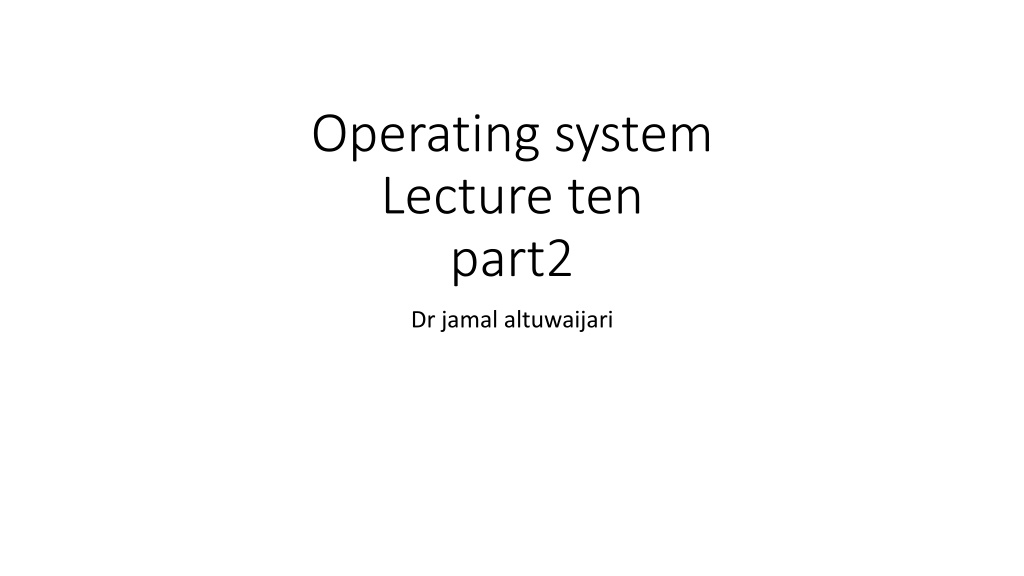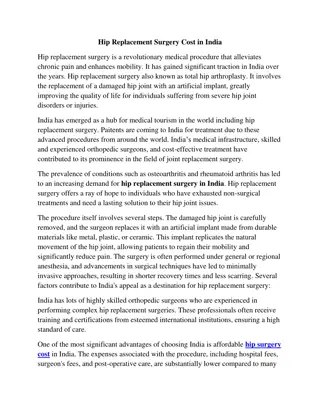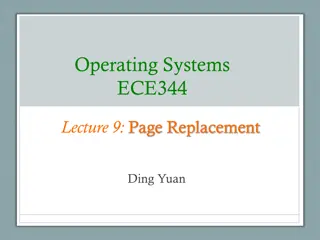Understanding Page Replacement Algorithms in Operating Systems
Explore different page replacement algorithms like Optimal, LRU, and LFU used in operating systems for efficient memory management. Learn how these algorithms work and their advantages and disadvantages with practical examples.
Download Presentation

Please find below an Image/Link to download the presentation.
The content on the website is provided AS IS for your information and personal use only. It may not be sold, licensed, or shared on other websites without obtaining consent from the author. Download presentation by click this link. If you encounter any issues during the download, it is possible that the publisher has removed the file from their server.
E N D
Presentation Transcript
Operating system Lecture ten part2 Dr jamal altuwaijari
2. 2. Optimal Algorithm Optimal Algorithm This algorithm has the lowest page-fault rate of all algorithms. And it will never suffer from Beladys for the longest period of time. Example Use the following reference string with three free frames show how many page-faults occurred By the OPT Alg. 7 0 1 2 0 3 0 4 2 3 0 3 2 1 2 0 1 7 0 1 7 7 7 2 2 2 0 0 0 0 4 1 1 3 3 2 0 3 2 0 1 7 0 1 1 2 3 4 5 6 7 8 9
2 2. . Optimal Algorithm Optimal Algorithm The page faults = 9. If better than FIFO algorithm, Disadvantage of OPT 5 difficult to implement because it requires future knowledge of the reference string
3. 3. LRU algorithm (least recently used) LRU algorithm (least recently used) If we use the recent past as an approximation of the near future then we will replace the page that has not been used for the longest period of time. The LRU associates with each page the time of that pages last use, when a page must be replaced LRU chooses that page that has not been used for the longest period of time. The result of applying LRU for our example Reference string produces (12) faults, 7 0 1 2 0 3 0 4 2 3 0 3 2 1 2 0 1 7 0 1 7 7 0 7 0 1 2 0 1 2 0 3 4 0 3 4 0 2 4 3 2 0 3 2 1 3 2 1 0 2 1 0 7
3 3. . LRU algorithm (least recently used) LRU algorithm (least recently used) The LRU Algorithm is often used and is considered to be quite good. The major problem is how to Implement LRU Algorithm If requires H/W, assistance. The LRU can be implemented either by: a. Counters: Associate with each page-table entry a time - of - use field. A counter is incremented for every memory reference, b. Stack: To keep stack for a page numbers and whenever a page referenced it is removed from the stack and put on the top. In this way used page and the bottom is the least
3. 3. LRU algorithm (least recently used) LRU algorithm (least recently used) Recently used page. See the figure below. Reference string: 7 0 7 1 0 1 2 1 2 7 1 2 2 1 0 7 4 7 2 1 0 4 a b Stack before stack after a b
4. 4. Least Least- -frequently frequently- -used (LFU) page replacement used (LFU) page replacement LFU keeps a counter of the number of references which have been made to each page. The Page with the smallest count is replaced.
5. 5. most most- -Frequently Frequently- -used (MFU) used (MFU) Page Replacement MFU argument that the page with the smallest count was probably just brought in and has yet to be used. Therefore the page With largest count is replaced, Note: Neither MFU nor LFU are very common the implementation of these algorithms is Expensive.
6 6. . Max Max Used Used Recently (NUR) Page Replacement Recently (NUR) Page Replacement Pages not used recently are not likely to be used in the near future and they may be replaced with in coming pages, Because it is desirable to replace a page that has not been changed while in primary storage, The NUR is implemented with addition of two HW bits per page these are: a. Reference bit = O of the page has not been referenced, = 1 if the page has not been referenced b. Modified bit = O if the page has not been modified (Dirty bit) = 1 if the page has been modified If we consider both bits we have the following four classes: 1. (O, O) neither used nor dirty. 2. (O.I) not used (recently) but dirty. 3. (I, O) used but clean. 4. (I, I) used only dirty. We replace a page in the lowest and empty class we can use FIFO or randomly among them.
10.5 10.5 Allocation of frames Allocation of frames How do we allocate the fixed amount of free frames among the varioly processes? There are many strategies to allocate frames for each process:
1. 1. Minimum number of frames Minimum number of frames We cannot allocate more than the total number of available frames (unless there is page Sharing) obviously as the number of frames allocated to each process decrease. The page fault-rate increases. Slowing process execution. There is a minimum number of frames that must be allocated and it defined by the instruction-set architecture, while the maximum number is defined by the amount of available physical memory.
2. 2. Global versus local allocating Global versus local allocating Global replacement allows a process to select a replacement frame from the set of all frames, even if that frame is currently allocated to other process, one process can take a frame from another. Local replacement require that each process select only from its own set of allocated frames. 3. Allocation Algorithms: The easiest way to split M frames among n processes is to give everyone an equal share M/n frames.
Example If there are 93 frames and 5 processes each process would get 18 frames left over 3 frames Could be used as buffer pool. This is called equal allocation. An alternative we can use proportional allocation. We allocate available memory to each process according to its size, Let the size of the virtual memory for process bi be si and define s= si Then if the total number of available frames is m we allocate ai frames to process pi, where a is approximately Si Ai=----------- *S S Example: Assume a memory of 32 frames and two processes p1=10k and p2=127k S=10+127=137 10 A1=--------- * 62=4 frames. 137 127 A2=-------- * 62=57 frames. 137
10.6 10.6 Thrashing Thrashing If the number of frames allocated to a low-priority process falls below the minimum number required by the computer architecture we must suspend its execution. (M.T.S. scheduling). A process is thrashing if it is spending more time paging than executing. This phenomenon is illustrated in the figure below; CPU utilization is plotted against the degree of multiprogramming. As the degree of M.P increases CPU utilization if the degree of multiprogramming is increased even further thrashing sets in and CPU utilization drops sharply. See the figure below. At this point to increase CPU utilization and stop thrashing we must decrease the degree of multiprogramming. The effects of thrashing can be limited by using a local or priority replacement algorithm.























